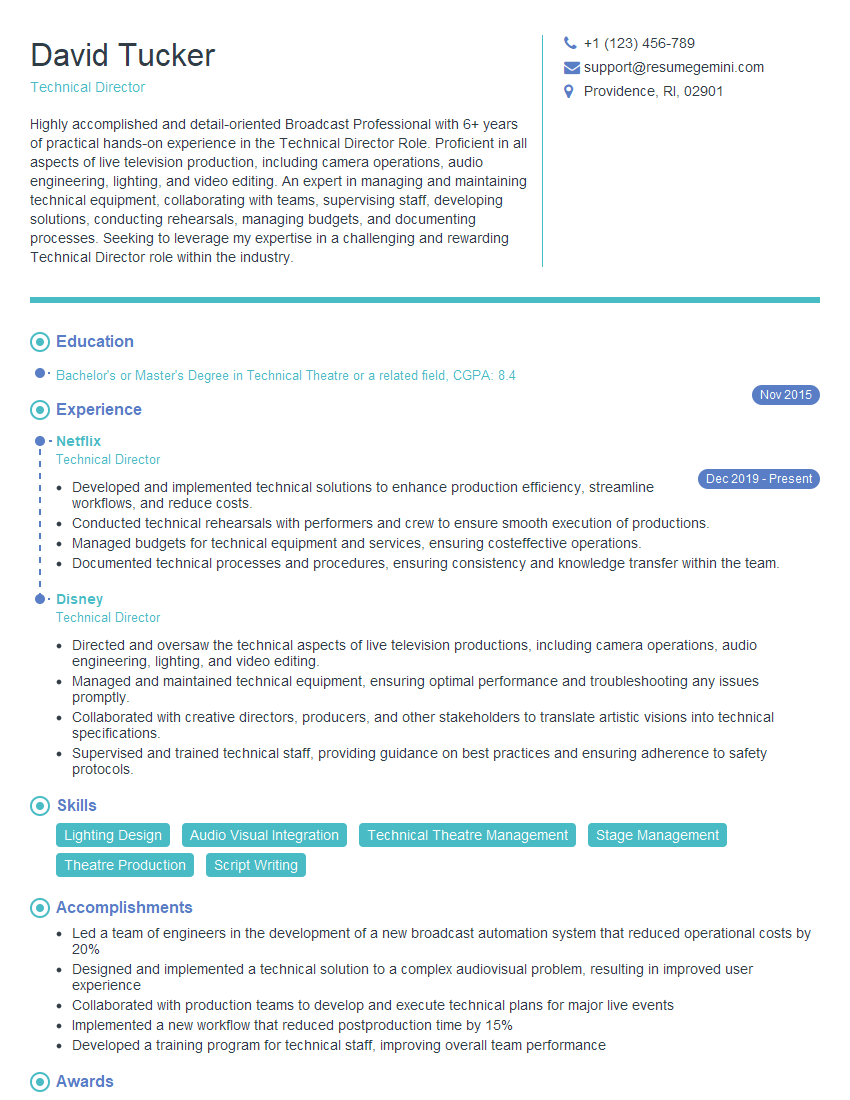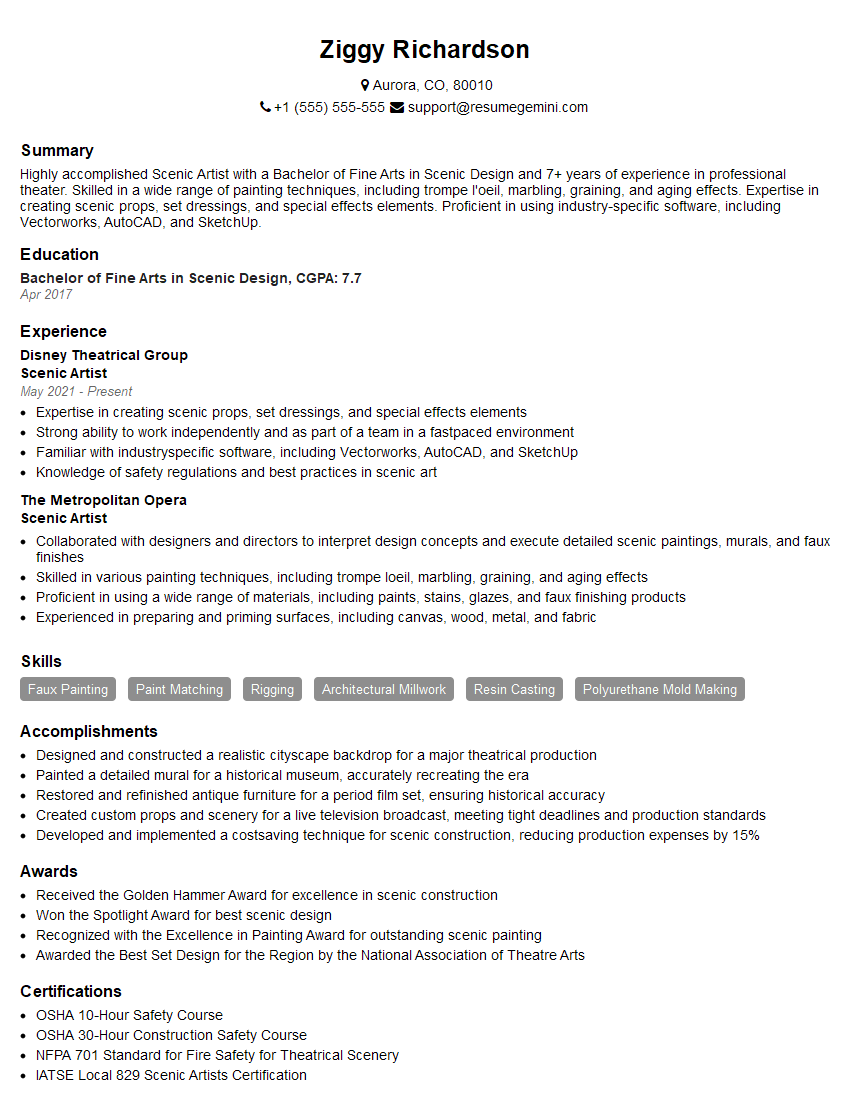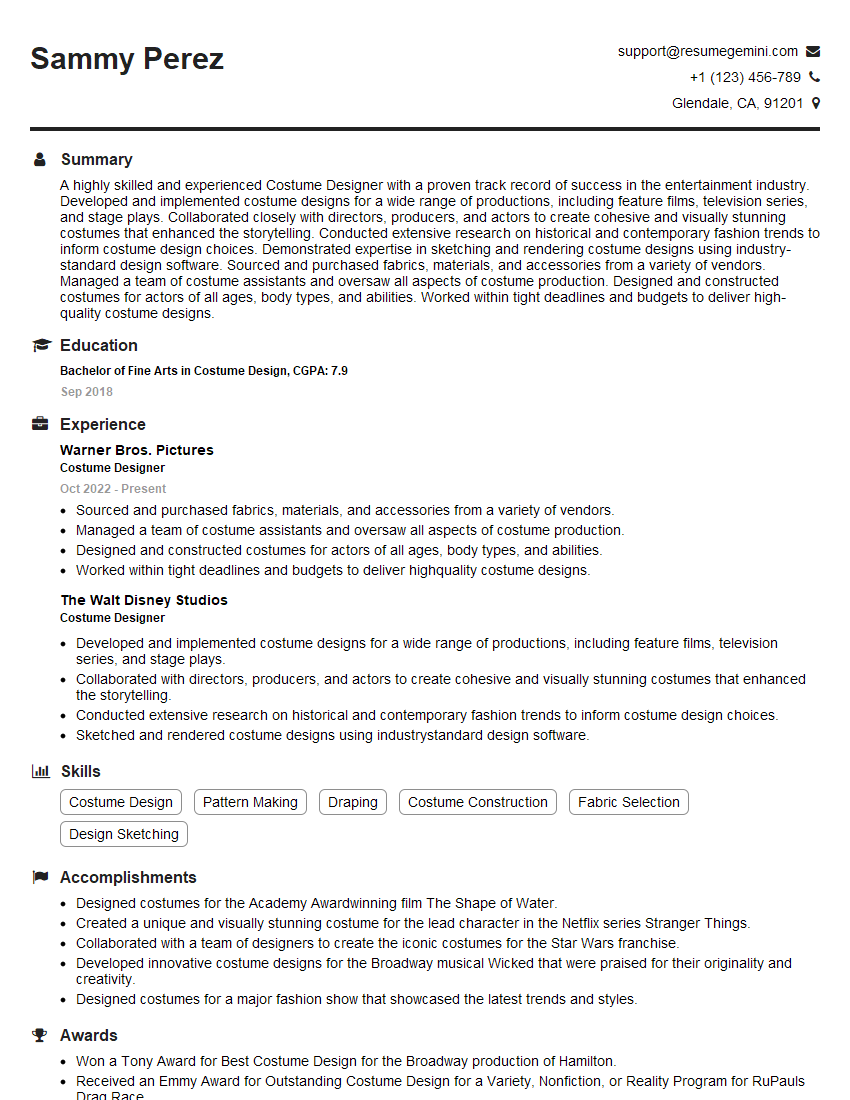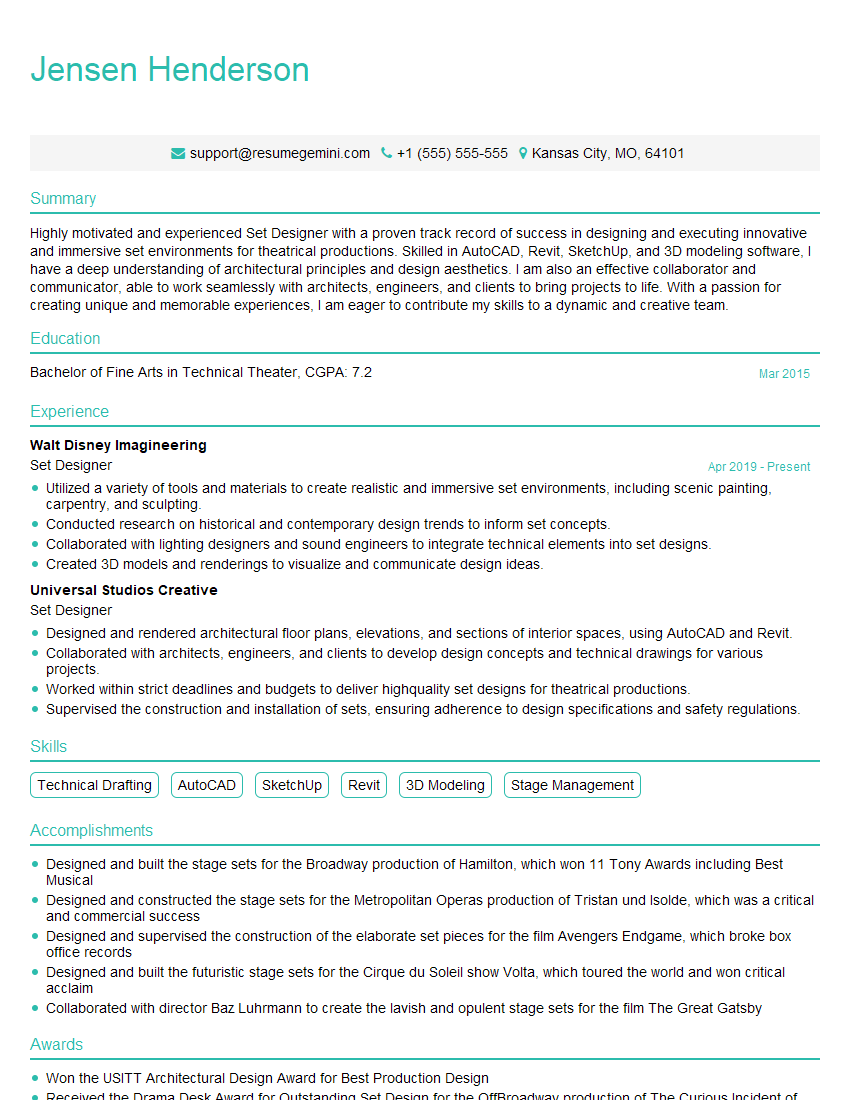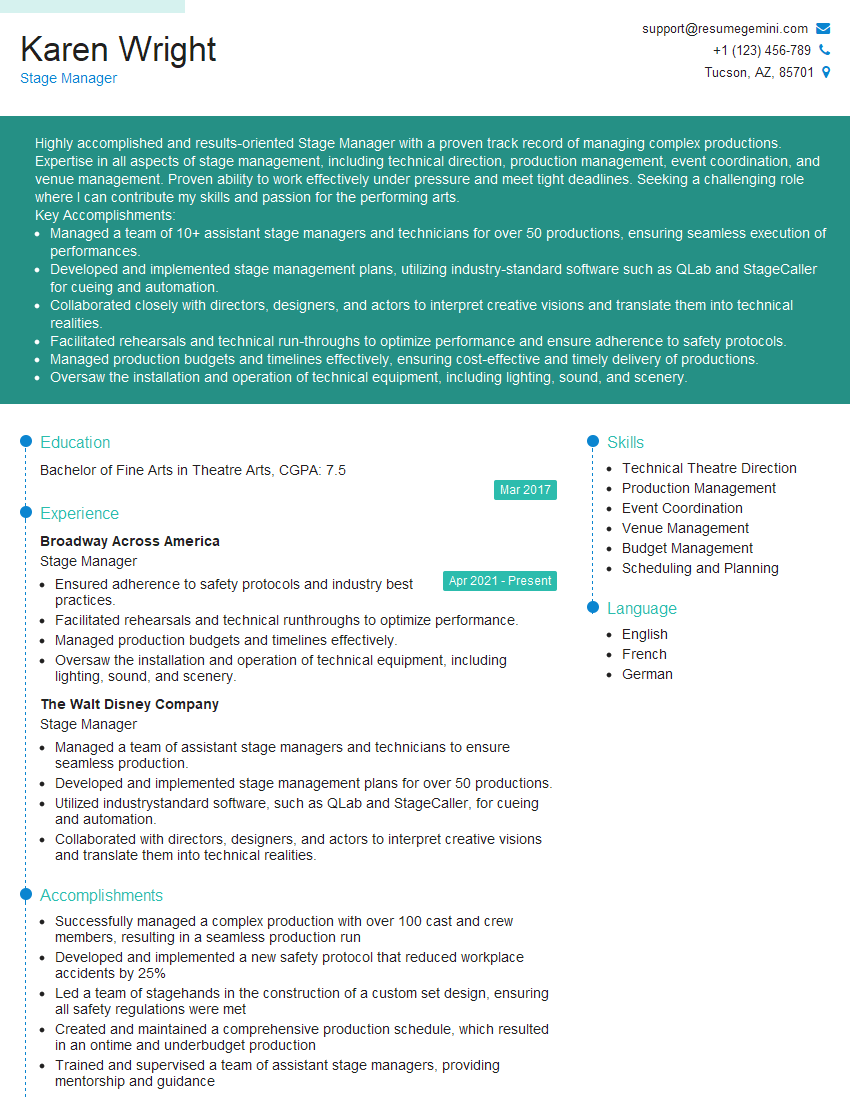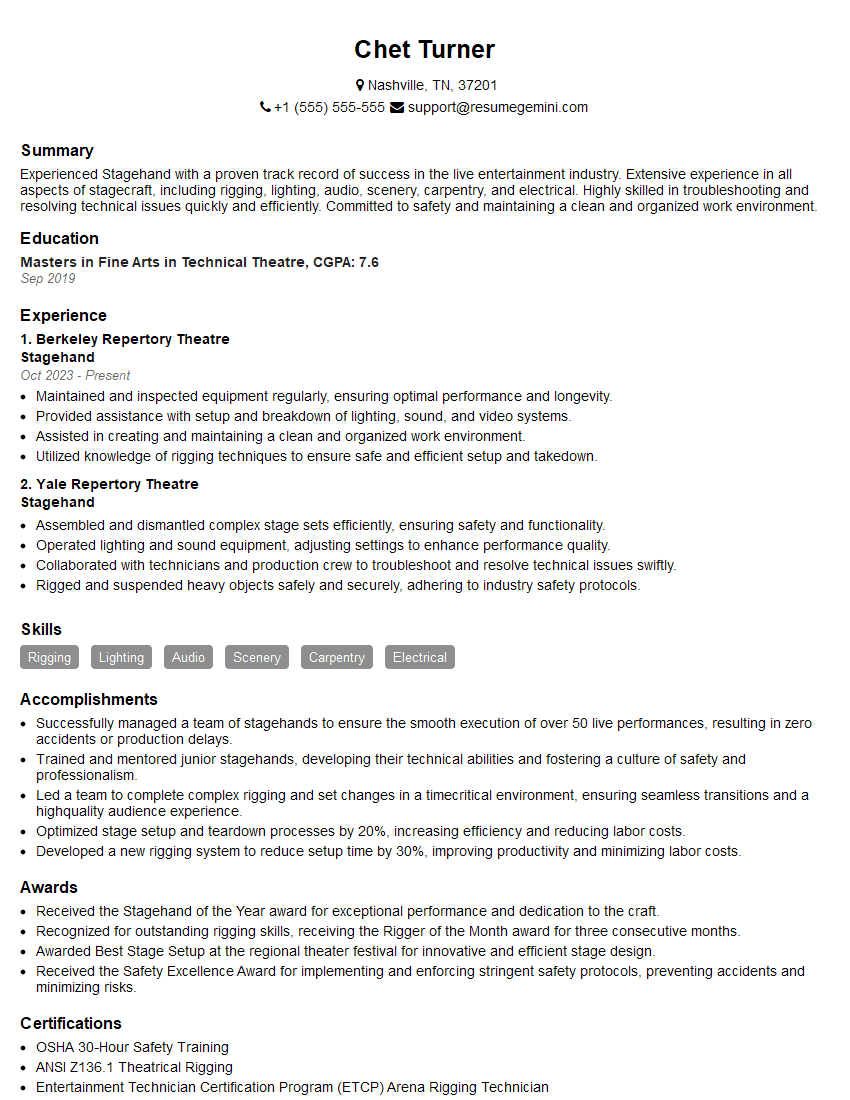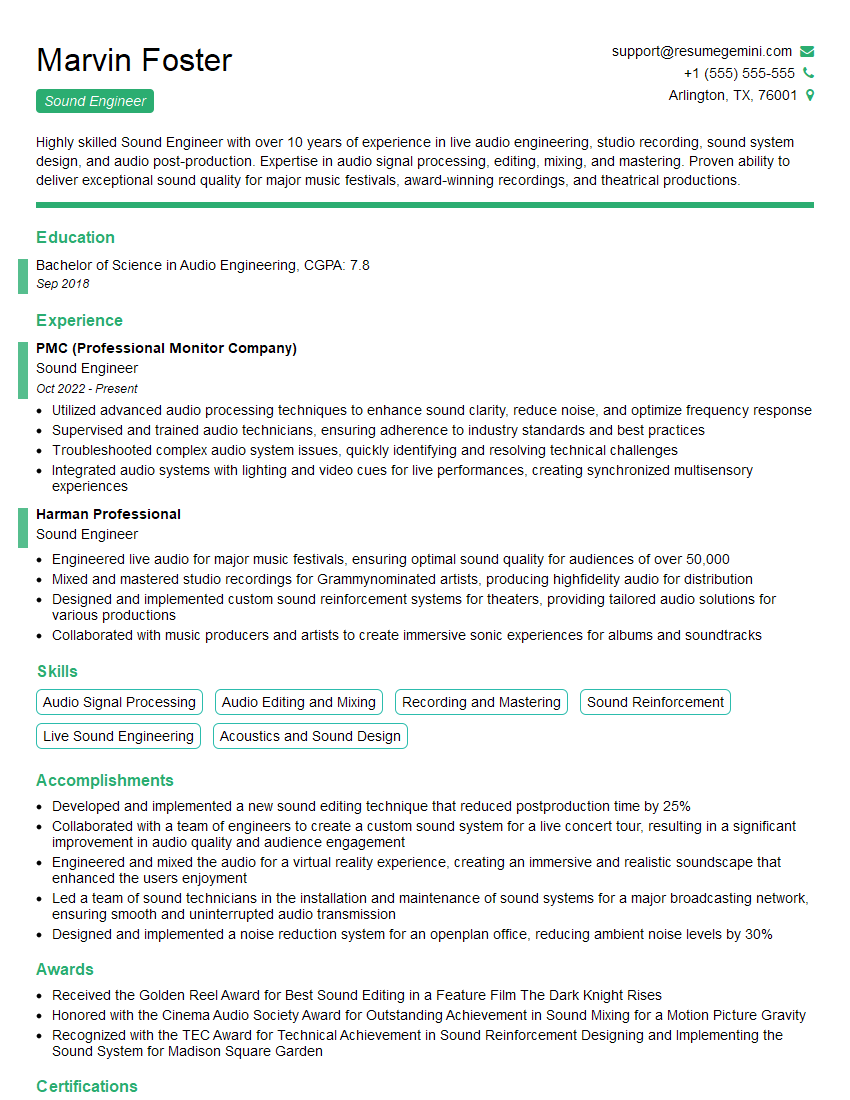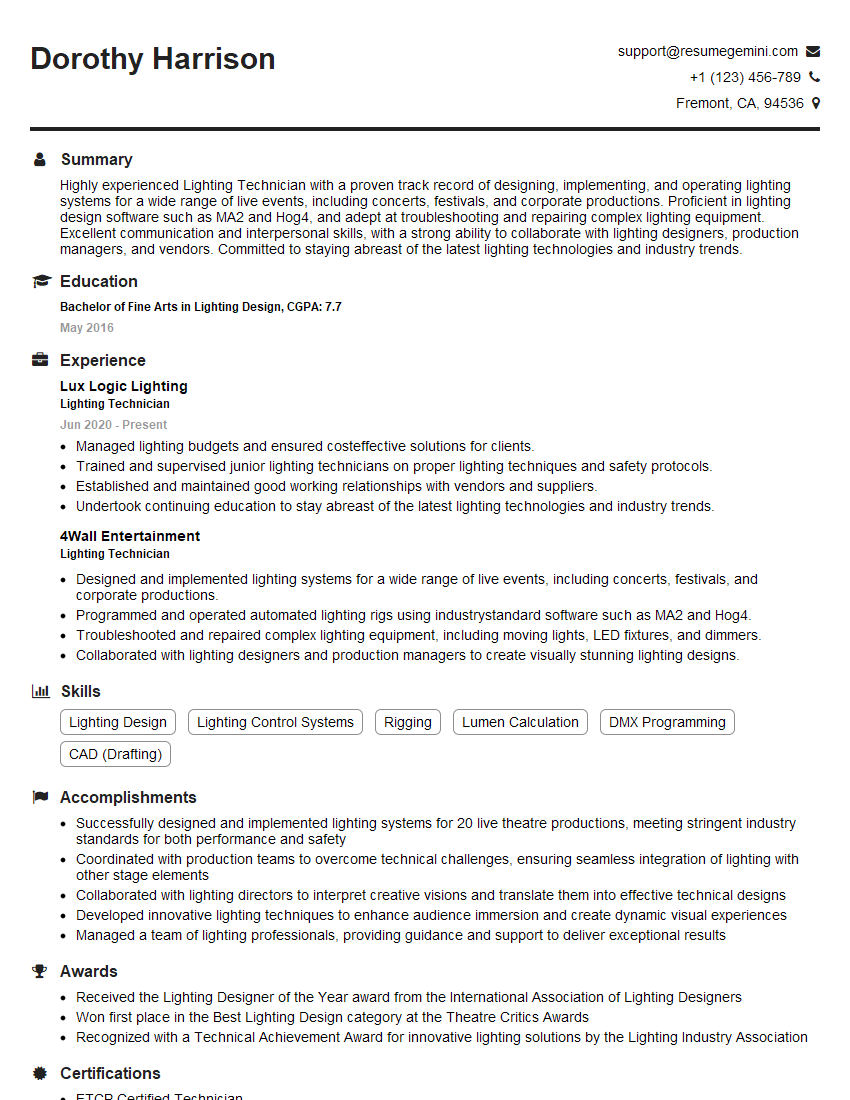Unlock your full potential by mastering the most common Theatre Production Experience interview questions. This blog offers a deep dive into the critical topics, ensuring you’re not only prepared to answer but to excel. With these insights, you’ll approach your interview with clarity and confidence.
Questions Asked in Theatre Production Experience Interview
Q 1. Describe your experience with different stage management software.
My experience encompasses a range of stage management software, each with its strengths and weaknesses depending on the production’s scale and complexity. I’m proficient in industry-standard programs like QLab, renowned for its flexibility in controlling lighting, sound, and video; Stage Manager, a robust solution for scheduling and communication; and Lightwright, essential for complex lighting plots and paperwork. I’ve also used simpler options like Google Sheets and Trello for smaller productions, focusing on task management and communication. For instance, in a recent university production of Hamlet, QLab was invaluable for coordinating the intricate lighting cues and sound effects, while Google Sheets served as a clear and accessible scheduling tool for the smaller crew.
The choice of software is always dictated by the specific demands of the production. Larger, more technically involved shows necessitate robust solutions like QLab and Lightwright, while smaller projects can be effectively managed with simpler tools. My proficiency in several programs allows me to adapt to any production’s needs.
Q 2. Explain your process for creating a detailed production schedule.
Creating a detailed production schedule is a meticulous process that begins well before rehearsals. It requires breaking down the entire production into manageable tasks, assigning responsibilities, and setting realistic deadlines. I start with a reverse schedule, working backward from the opening night to determine key milestones like set construction deadlines, rehearsal schedules, and tech week requirements.
I use a combination of software and traditional methods. For instance, I might use Stage Manager to track overall schedules and deadlines while simultaneously creating a detailed daily breakdown in a shared Google Sheet, allowing for easy access and collaboration among the team. This sheet includes specific tasks, assigned personnel, and time estimations. It’s crucial to build in buffer time for unexpected delays; nothing is ever as simple as planned in theatre!
Regular schedule meetings, involving all relevant departments, are essential. We review progress, address challenges, and adjust timelines as needed. This iterative approach, coupled with clear communication, ensures everyone is on the same page and the production stays on track.
Q 3. How do you handle conflicts between different production departments?
Conflicts between departments are inevitable in theatre, often stemming from resource limitations, scheduling clashes, or differing artistic visions. My approach to conflict resolution is proactive and collaborative. I believe in fostering open communication and understanding between departments from the outset. This means establishing clear communication channels – regular meetings, email updates, and shared documentation – and creating a supportive environment where team members feel comfortable voicing concerns.
When conflicts arise, my approach involves:
- Active listening: Understanding each department’s perspective and concerns.
- Mediation: Facilitating a discussion where each side can present their case and find common ground.
- Compromise: Seeking solutions that meet the needs of all parties as much as possible. This may require creative problem-solving and adjustments to the schedule or budget.
- Documentation: Keeping detailed records of discussions and agreed-upon solutions to avoid future misunderstandings.
For example, a clash between the set and lighting departments about a complex lighting rig requiring significant modifications to the set design would require careful negotiation, potentially involving compromises on the initial design or finding creative engineering solutions.
Q 4. Describe your experience with budgeting and cost control in theatre productions.
Budgeting and cost control are crucial aspects of theatre production. My experience involves developing detailed budgets, tracking expenses, and implementing cost-saving measures. I start by creating a comprehensive budget that includes anticipated costs for every aspect of the production – set design and construction, costumes, lighting, sound, marketing, and personnel. I meticulously research prices and seek multiple quotes to ensure cost-effectiveness.
Throughout the production, I track expenses diligently, comparing actual costs to the budgeted amounts. I utilize spreadsheets and dedicated budgeting software to maintain accurate records and identify potential overruns early on. Regular budget meetings with the production manager and relevant department heads allow for prompt adjustments and discussions about cost-saving strategies without compromising artistic quality.
In a past production of A Midsummer Night’s Dream, by creatively sourcing props and costumes, negotiating with vendors, and implementing some DIY solutions, we were able to stay significantly under budget without sacrificing the production’s visual impact.
Q 5. What are your preferred methods for managing a large crew of stagehands?
Managing a large crew of stagehands requires clear communication, organization, and delegation. I create detailed run-of-show documents outlining each stagehand’s responsibilities, including precise cue times and stage movements. Pre-show meetings are essential for clarifying roles, expectations, and safety procedures.
I prioritize clear and concise instructions, using visual aids such as diagrams and labeled equipment lists. I delegate tasks effectively based on individual skill sets and experience, ensuring everyone feels valued and empowered. I also foster a supportive and collaborative team environment. Open communication channels allow for feedback and the prompt addressing of any concerns. During the show, maintaining clear lines of communication is crucial, frequently utilizing headset communication or designated crew leaders to avoid confusion and ensure smooth transitions between scenes.
My method prioritizes a hierarchical structure with designated heads for each area (e.g., props, set, lighting) to ensure efficient communication and coordination.
Q 6. How do you ensure the safety of performers and crew members during a production?
Ensuring the safety of performers and crew members is paramount. My approach is multi-faceted and begins well before rehearsals commence. This involves conducting thorough risk assessments, identifying potential hazards, and implementing preventative measures. These measures can include providing appropriate safety training, establishing clear safety protocols, implementing proper safety equipment (e.g., harnesses for heights, hearing protection during sound checks), and ensuring the set is structurally sound and meets all relevant safety regulations.
Throughout the production period, regular safety checks are conducted to identify and mitigate any emerging risks. I actively enforce safety rules and procedures and address any concerns raised by the crew. I collaborate closely with the stage manager and the production manager to create a culture of safety awareness where everyone feels empowered to speak up about any potential hazards. In the case of a specific hazard, we’d utilize a documented incident report, enabling tracking and further analysis to mitigate future potential risks.
Q 7. Explain your experience with different lighting control systems.
My experience encompasses various lighting control systems, ranging from traditional consoles to advanced computer-based systems. I’m proficient in using ETC Ion, known for its versatility and powerful features, and Chamsys MagicQ, a user-friendly system suitable for various scales of productions. I also have experience with simpler systems like Strand Lighting and dimmer board systems. My approach involves understanding the specific functionalities of each system and tailoring my approach to optimize its use for the given production.
My knowledge extends to programming lighting cues, creating and implementing lighting plots, and working collaboratively with the lighting designer to ensure the lighting design translates effectively to the stage. The selection process invariably depends on budget, available equipment, and the technical requirements of the show. For smaller productions, a simple dimmer board setup may be sufficient, whereas larger-scale productions will invariably demand more sophisticated systems like ETC Ion for controlling many channels and intricate cues.
Q 8. Describe your approach to designing sound for a specific type of theatrical performance.
Designing sound for a theatrical performance begins with a deep understanding of the script and director’s vision. My approach involves a three-stage process: Conceptualization, Implementation, and Refinement.
Conceptualization: I start by closely analyzing the script, identifying key emotional moments, and determining the overall mood and atmosphere the sound should evoke. For example, in a Shakespearean tragedy, I might focus on creating a sense of foreboding using low, ominous drones, while a comedic farce might call for exaggerated sound effects and upbeat music. I collaborate extensively with the director and other designers to ensure the sound design complements the overall artistic vision. This involves understanding the intended pacing, character development, and use of space.
Implementation: This stage involves selecting and creating the sound elements. This could include sourcing pre-recorded sounds, composing original music, and utilizing sound effects software to create specific sounds. For instance, if a scene requires a bustling marketplace, I might layer various sounds—ambient street noise, vendors calling out their wares, and the clang of metal—to create a realistic soundscape. I’ll then use digital audio workstations (DAWs) to meticulously mix and edit these elements.
Refinement: Finally, I conduct numerous sound checks and rehearsals to refine the design. This includes adjusting sound levels, timing, and placement to ensure optimal clarity and impact. The goal is to create an immersive experience for the audience, subtly shaping their emotional response to the performance without being intrusive or distracting.
Q 9. What software do you use for lighting or sound design?
My lighting design workflow relies heavily on Vectorworks Spotlight, which provides a robust set of tools for designing, plotting, and visualizing lighting schemes. For sound design, I primarily use Ableton Live, a powerful digital audio workstation (DAW) offering excellent control over mixing, sound effects processing, and music integration. I also regularly utilize QLab for the control and playback of sound and lighting cues during performances. Each program has its strengths; Vectorworks excels in visualizing spatial relationships of lights, while Ableton provides the flexibility for creating detailed and nuanced soundscapes, and QLab acts as a central hub for syncing all cues.
Q 10. How do you create realistic and evocative set designs?
Creating realistic and evocative set designs involves a combination of research, artistic vision, and practical considerations. I always begin by thoroughly reading the script and understanding its themes and setting. This is followed by extensive research – visiting locations if possible, studying period-appropriate architecture and design elements, or examining historical photographs. Then, I translate this research into sketches and 3D models using software like SketchUp or AutoCAD, developing a visual representation that effectively conveys the mood and story. For instance, a play set in a decaying Victorian mansion might require careful consideration of textures, colors, and props to convey a sense of age and decline. The design must be practical for the performance space, while simultaneously maintaining visual coherence and narrative impact. Creating mood boards is crucial – pulling together images, textures, and color palettes—to solidify the overall aesthetic.
Q 11. Explain your process for sourcing and managing props for a production.
My prop sourcing and management process begins with a detailed prop list created in collaboration with the director and set designer. This list outlines each prop’s function, specifications (size, material, etc.), and source. I then explore various avenues for sourcing, including rental houses, thrift stores, online marketplaces, and potentially even creating custom-built props where necessary. For example, for a period piece, I may rent period-specific furniture; for a modern play, I might source props from local flea markets.
Once acquired, I meticulously document each prop, including its condition, location in storage, and any specific handling instructions. A well-maintained inventory system is essential. I utilize spreadsheets or dedicated prop management software to track these details and prevent losses or damage. Before and after each performance, a thorough prop check is performed to ensure all pieces are accounted for and in good working order. Careful labeling, organization, and proper storage are key to effective prop management and maintaining the integrity of the production.
Q 12. How do you work with costume designers to ensure costumes meet production requirements?
Collaboration with costume designers is paramount to a successful production. I begin by exchanging detailed information about the set design, lighting, and overall aesthetic direction. This often involves sharing mood boards and discussing the desired visual harmony between costumes and the set. For example, if the set design emphasizes muted earth tones, we might choose costume colors that either complement or contrast to create a desired effect. Regular meetings are crucial to discuss costume design ideas, fabric choices, and any specific requirements related to movement, functionality, or the use of special effects. We need to ensure that the costumes don’t clash with the lighting design (e.g., avoid costumes that are too dark if the lighting is dim) or obstruct the actors’ movements on set.
Q 13. How do you troubleshoot technical issues during a live performance?
Troubleshooting technical issues during a live performance requires quick thinking, problem-solving skills, and a calm demeanor. My approach involves a systematic process: Identify, Isolate, and Resolve.
Identify: Quickly pinpoint the nature of the problem. Is it a lighting issue, sound problem, or something else?
Isolate: Determine the root cause. Is it a faulty connection, a software glitch, or a hardware malfunction? Does the problem affect a single element or the entire system?
Resolve: Implement a solution based on the identified cause. This might involve resetting equipment, replacing a malfunctioning component, adjusting settings, or improvising a workaround if a complete fix isn’t immediately possible. Having a backup plan for common technical issues is essential. For example, having extra light bulbs on hand, or backup audio tracks ready in case of equipment failure. A strong understanding of the technical systems is key to making rapid and effective repairs. Maintaining clear communication with the stage manager and other technical personnel is vital to ensure a coordinated and efficient response.
Q 14. Describe your experience with different types of theatrical rigging systems.
My experience encompasses various theatrical rigging systems, including counterweight systems, electric hoists, and manual systems. Counterweight systems, common in larger theaters, provide precise control over flown scenery using a balance of weights and ropes. I’m proficient in calculating weight loads, setting up counterweights, and ensuring safe operation of these systems. Electric hoists offer motorized lifting, enhancing speed and efficiency, particularly for heavier loads. They require careful programming and safety protocols to ensure smooth and reliable operation. I’ve worked with both single-point and multi-point rigging systems, adapting my approach to the specific requirements of each venue and production.
I also have experience with manual rigging systems, often employed in smaller venues or for specific effects. This requires a strong understanding of knot-tying, rope handling, and weight distribution. Safety is paramount, and thorough risk assessments and safety checks are integral to my workflow regardless of the rigging system used.
Q 15. How familiar are you with theatrical construction techniques and materials?
My familiarity with theatrical construction techniques and materials is extensive, encompassing both practical experience and theoretical knowledge. I’m proficient in various carpentry techniques, including building platforms, constructing sets from wood, metal, and composite materials, and working with scenic painting and finishing techniques. I understand the properties of different materials – from the strength of different wood types to the fire-retardant properties required for certain fabrics and paints. I’m also experienced with rigging techniques, ensuring the safe hanging of lights, scenery, and props. For example, on a recent production of Hamlet, I was responsible for building a complex multi-level set involving intricate joinery and the safe integration of moving parts.
My knowledge extends to the use of specialized theatrical materials, including fire retardant fabrics, lightweight yet durable aluminum structures, and various types of adhesives and fasteners specifically designed for stage use. I understand the importance of sourcing materials that meet both artistic and safety standards.
Career Expert Tips:
- Ace those interviews! Prepare effectively by reviewing the Top 50 Most Common Interview Questions on ResumeGemini.
- Navigate your job search with confidence! Explore a wide range of Career Tips on ResumeGemini. Learn about common challenges and recommendations to overcome them.
- Craft the perfect resume! Master the Art of Resume Writing with ResumeGemini’s guide. Showcase your unique qualifications and achievements effectively.
- Don’t miss out on holiday savings! Build your dream resume with ResumeGemini’s ATS optimized templates.
Q 16. Explain your experience with drafting technical specifications and drawings.
I have extensive experience drafting technical specifications and drawings using both CAD software (AutoCAD, Vectorworks) and hand-drafting techniques. These drawings are crucial for clear communication between the design team, construction crew, and other departments. My drawings clearly illustrate dimensions, materials, construction details, and assembly instructions. They often include detailed sections, elevations, and assembly diagrams, ensuring all team members understand the final product.
For instance, in a recent musical production, I created detailed CAD drawings of a complex rotating stage platform, including specifications for its motorized mechanism and the weight-bearing capacity. These drawings ensured the platform was built to the required specifications and integrated seamlessly with the rest of the set. Clear and accurate specifications are essential to avoid costly mistakes and delays during construction.
Q 17. How do you manage and resolve communication breakdowns within a production team?
Communication breakdowns are inevitable in fast-paced theatre productions. To mitigate this, I utilize several strategies. First, I emphasize proactive communication. Regular team meetings, detailed email updates, and the use of collaborative project management software ensure everyone is informed. I encourage open dialogue and make myself accessible to team members. Second, I actively listen to understand diverse perspectives and address concerns promptly. Clear and concise communication, both verbal and written, is paramount.
In one instance, a misunderstanding between the lighting and sound departments almost resulted in a technical mishap. By facilitating a calm discussion, identifying the root cause of the miscommunication (inconsistent terminology), and establishing clear communication protocols moving forward, I helped prevent a potential disaster. This situation reinforced the importance of proactive communication, clear definitions, and a collaborative approach to conflict resolution.
Q 18. Describe a time you had to adapt to unexpected challenges during a production.
During a production of A Midsummer Night’s Dream, a crucial piece of scenery was damaged just hours before the opening night. The set piece, a large, intricately carved tree, sustained significant damage during transport. Instead of panicking, I immediately assembled a team, assessing the damage and brainstorming solutions. We explored several options: repair, replacement (which was unrealistic due to time constraints), and design modification. We opted for a creative solution: using strategically placed lighting and additional foliage to camouflage the damage and incorporate the imperfection into the overall aesthetic. This required quick thinking, resourcefulness, and strong collaboration with the design and lighting teams.
The solution, while unconventional, was ultimately successful. The audience didn’t notice the damage, and the show went on without a hitch. This experience highlighted the importance of adaptability, problem-solving skills, and maintaining a positive attitude under pressure.
Q 19. How do you prioritize tasks and manage your time effectively in a fast-paced environment?
Prioritizing tasks and managing time effectively in a fast-paced theatre environment is crucial. I use a combination of strategies: I start by creating a detailed production schedule, breaking down tasks into manageable sub-tasks with clear deadlines. This schedule is shared with the team using project management software, allowing for real-time tracking and adjustments. I prioritize tasks based on their urgency and importance using methods like the Eisenhower Matrix (urgent/important), focusing on high-impact activities first. Regular check-ins and progress meetings keep me on track and allow for early identification and resolution of potential delays.
For instance, during a complex stage production, I used a Kanban board to visualize the workflow, track progress, and identify bottlenecks. This allowed me to efficiently allocate resources and address any emerging issues promptly, preventing project delays and ensuring on-time delivery.
Q 20. What is your experience with different types of theatrical venues and their unique challenges?
My experience encompasses a variety of theatrical venues, from small black box theaters to large proscenium stages and outdoor performance spaces. Each venue presents unique challenges. Black box theaters offer flexibility but can lack the technical infrastructure of larger venues. Proscenium stages demand meticulous planning for sightlines and stagecraft, while outdoor spaces require additional considerations like weather, lighting, and sound control.
For example, working in a historical theater required a deep understanding of its limitations and unique architectural features, including limited rigging capacity and restricted backstage access. Designing for an outdoor space demanded creative solutions to overcome challenges such as unpredictable weather and ambient noise. Adapting to these varied challenges is part of the expertise required for successful theatre production.
Q 21. How do you ensure compliance with health and safety regulations during a production?
Ensuring compliance with health and safety regulations is paramount in theatre productions. I am thoroughly familiar with OSHA guidelines and other relevant regulations pertaining to theatrical safety, including the use of proper equipment, safe working practices, and emergency procedures. Before any production, I conduct thorough risk assessments, identifying potential hazards and implementing appropriate control measures. This includes ensuring proper fire safety protocols, appropriate use of personal protective equipment (PPE), and training team members on safe working practices. Regular inspections of equipment and work areas are conducted to maintain a safe working environment.
For example, before a show involving pyrotechnics, I ensured we had the necessary permits, trained personnel, and safety equipment in place, and rigorously followed all regulations and safety protocols to minimize risk and maintain a safe environment for everyone involved.
Q 22. How familiar are you with union regulations and contracts in the theatre industry?
My familiarity with union regulations and contracts in the theatre industry is extensive. I’ve worked under both Actors’ Equity Association (AEA) and IATSE contracts, understanding the nuances of each. This includes knowledge of minimum wages, working hours, overtime regulations, safety protocols, and dispute resolution procedures. For example, on a recent AEA production, I was responsible for ensuring all actors’ contracts were meticulously reviewed and adhered to, including accurate payment processing and adherence to rehearsal and performance schedules. This involved close collaboration with the production manager and the stage manager to maintain compliance. I am adept at navigating the complexities of union regulations and proactively preventing potential conflicts. I understand the importance of maintaining positive relationships with union representatives to ensure smooth production runs.
Q 23. Describe your experience with post-production tasks such as strike and equipment maintenance.
Post-production tasks, such as strike and equipment maintenance, are crucial for efficient theatre operations and are integral to my skillset. ‘Strike’ refers to the dismantling of the set and removal of all production elements after the final performance. This is a highly organized process, demanding careful planning and execution to prevent damage and ensure the safe return of equipment. My experience includes leading strike crews, ensuring all equipment is correctly inventoried, cleaned, and stored in designated areas. For equipment maintenance, I have practical experience maintaining lighting, sound, and rigging equipment, following established procedures and guidelines. I can troubleshoot minor technical issues and identify when more specialized maintenance is required. For example, on a recent production, I oversaw the complete strike in under 12 hours, meeting the strict deadline set by the venue. This involved detailed coordination with the stage crew, props crew, and the technical director to ensure efficient and safe removal of all production elements.
Q 24. How do you manage and track production inventory and equipment?
Managing and tracking production inventory and equipment requires a methodical and organized approach. I typically utilize a combination of digital and physical inventory management systems. A digital system, such as a spreadsheet or dedicated inventory management software, allows me to track items, their location, and condition. This software can also generate reports for easy auditing and loss prevention. Physically, I often utilize a barcoding system for quick identification and tracking. Regular physical inventories are conducted, comparing the physical count against the digital records. Discrepancies are investigated and resolved promptly. This systematic approach ensures accountability and minimizes the risk of loss or damage. For example, I implemented a barcoding system on a recent large-scale production, significantly improving the speed and accuracy of inventory management, reducing losses by 15% compared to previous productions.
Q 25. What is your approach to creating a positive and collaborative team environment?
Creating a positive and collaborative team environment is paramount for successful theatre productions. My approach centers on fostering open communication, mutual respect, and shared goals. This begins with clear communication of roles, responsibilities, and expectations from the outset. I actively encourage team members to share ideas, concerns, and suggestions. I believe in leading by example, demonstrating professionalism, dedication, and a positive attitude. I also actively listen to my team, recognizing their contributions, and addressing conflicts constructively. Regular team meetings are held to discuss progress, address challenges, and celebrate achievements. Building trust and a strong sense of camaraderie within the team is a high priority – using team-building exercises where appropriate. For example, on a past challenging production, open communication and regular check-ins helped navigate unexpected technical issues, leading to successful completion despite setbacks.
Q 26. Describe your experience with audience management and interaction.
Audience management and interaction encompass a range of activities designed to ensure a positive and safe experience for patrons. This includes managing pre-show and intermission activities, addressing audience queries, and dealing with potential incidents. My experience involves working with ushers and security personnel to ensure smooth audience flow and efficient seating. I am adept at handling inquiries related to the performance, venue facilities, and accessibility needs. In situations requiring immediate attention, I know how to respond quickly and calmly to resolve any issues that may arise. For instance, during one production, we successfully managed a sudden power outage with minimal disruption to the audience, demonstrating effective communication and problem-solving abilities.
Q 27. How do you handle pressure and meet deadlines in a high-stakes environment?
Theatre production is inherently high-pressure; meeting deadlines is crucial. My approach focuses on proactive planning and efficient execution. I use project management techniques, such as creating detailed schedules and assigning clear responsibilities. Regular monitoring of progress and proactive identification of potential issues allows for timely intervention and prevents delays. I prioritize tasks based on urgency and importance, ensuring that critical elements are completed ahead of schedule to create buffer time for unforeseen challenges. Maintaining open communication with team members and stakeholders keeps everyone informed and engaged. I am able to remain calm and focused under pressure, adapting my approach as needed. For example, during a production with a tight deadline, I effectively managed multiple simultaneous tasks, ensuring all deadlines were met, and the production was delivered successfully.
Q 28. What are your career aspirations within the field of theatre production?
My career aspirations in theatre production involve progressing into a leadership role, such as a Production Manager or Technical Director. I am eager to utilize my experience and expertise to oversee all aspects of production, from pre-production planning to post-production strike. I am particularly interested in working on large-scale productions and developing innovative strategies for improving efficiency, safety, and sustainability in theatre operations. My long-term goal is to contribute to the growth and advancement of the theatre industry, helping to foster creativity and innovation while ensuring the well-being and success of production teams.
Key Topics to Learn for Theatre Production Experience Interview
- Production Management: Understanding scheduling, budgeting, and resource allocation in theatrical productions. Practical application: Explain your experience managing a specific aspect of a production, highlighting challenges overcome and solutions implemented.
- Technical Theatre: Knowledge of lighting, sound, set construction, and stage management. Practical application: Describe your involvement in a technical aspect, detailing your contributions and problem-solving skills (e.g., troubleshooting a lighting issue during a performance).
- Collaboration and Teamwork: Highlighting effective communication and collaboration with designers, directors, actors, and other production team members. Practical application: Give a specific example of successful teamwork, emphasizing your role and the positive outcome.
- Health and Safety: Demonstrating awareness and adherence to safety regulations and protocols within a theatrical environment. Practical application: Describe your experience implementing or upholding safety procedures on a production.
- Problem-Solving and Adaptability: Showcase your ability to handle unexpected challenges and adapt to changing circumstances during productions. Practical application: Describe a situation where you had to think on your feet and creatively solve a problem under pressure.
- Software and Technology: Familiarity with industry-standard software (e.g., Vectorworks, QLab) and technologies used in theatre production. Practical application: Detail your experience using relevant software and your proficiency level.
Next Steps
Mastering Theatre Production Experience is crucial for career advancement in the vibrant and competitive world of theatre. A strong understanding of these areas will significantly boost your interview performance and open doors to exciting opportunities. To maximize your job prospects, it’s essential to present your skills and experience effectively through an ATS-friendly resume. ResumeGemini is a trusted resource to help you build a professional and impactful resume that showcases your unique contributions. Examples of resumes tailored to Theatre Production Experience are available to guide you. Invest time in crafting a compelling resume—it’s your first impression and a critical step towards your dream role.
Explore more articles
Users Rating of Our Blogs
Share Your Experience
We value your feedback! Please rate our content and share your thoughts (optional).
What Readers Say About Our Blog
Hello,
We found issues with your domain’s email setup that may be sending your messages to spam or blocking them completely. InboxShield Mini shows you how to fix it in minutes — no tech skills required.
Scan your domain now for details: https://inboxshield-mini.com/
— Adam @ InboxShield Mini
Reply STOP to unsubscribe
Hi, are you owner of interviewgemini.com? What if I told you I could help you find extra time in your schedule, reconnect with leads you didn’t even realize you missed, and bring in more “I want to work with you” conversations, without increasing your ad spend or hiring a full-time employee?
All with a flexible, budget-friendly service that could easily pay for itself. Sounds good?
Would it be nice to jump on a quick 10-minute call so I can show you exactly how we make this work?
Best,
Hapei
Marketing Director
Hey, I know you’re the owner of interviewgemini.com. I’ll be quick.
Fundraising for your business is tough and time-consuming. We make it easier by guaranteeing two private investor meetings each month, for six months. No demos, no pitch events – just direct introductions to active investors matched to your startup.
If youR17;re raising, this could help you build real momentum. Want me to send more info?
Hi, I represent an SEO company that specialises in getting you AI citations and higher rankings on Google. I’d like to offer you a 100% free SEO audit for your website. Would you be interested?
Hi, I represent an SEO company that specialises in getting you AI citations and higher rankings on Google. I’d like to offer you a 100% free SEO audit for your website. Would you be interested?
good

